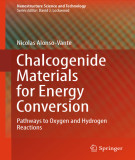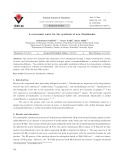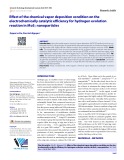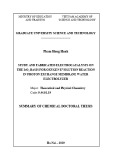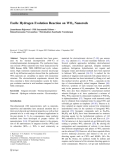
Hydrogen evolution reaction
-
Ebook "Chalcogenide materials for energy conversion: Pathways to oxygen and hydrogen reactions" addresses electrocatalysis based on chalcogenides, particularly in the nanoscale domain. Special attention is paid to the hydrogen evolution reaction (HER) and the oxygen reduction reaction (ORR). The book provides an introduction to materials synthesis; the basic principles of electrocatalysis; related precious metal versus non-precious metal catalytic center chalcogenides as well as supports; and the role of such supports in stabilizing the catalytic centers.
 234p
234p  tracanhphuonghoa1007
tracanhphuonghoa1007
 22-04-2024
22-04-2024
 7
7
 3
3
 Download
Download
-
Cellulose nanowhiskers (CNW) from cotton, was prepared by acid hydrolysis and purified using a size selection process to obtain homogeneous samples with average particle size of 270 nm and 85.5% crystallinity. Purified CNW was used as precursor to carbon nanoneedles (CNN) synthesis.
 7p
7p  vihermione
vihermione
 06-01-2023
06-01-2023
 12
12
 2
2
 Download
Download
-
The present work describes the preparation of new thiadiazoles through a simple intramolecular reaction of mono- and bis-hydrazonoyl halides with methyl hydrogen phenyl carbonimidodithioate or methyl-2-arylidene hydrazinecarbodithioate. The synthetic method involves nucleophilic substitution followed by intramolecular cyclization reactions mediated by evolution of methanethiol. The structures of the title compounds were elucidated by elemental analyses, and FTIR, MS and NMR spectra.
 8p
8p  langthannam
langthannam
 29-12-2021
29-12-2021
 8
8
 0
0
 Download
Download
-
The optimum growth time was acquired to be 11 hours. Thereby such obtained electrode exhibited the maximum HER activity with onset over the potential of 220 mV versus reversible hydrogen electrode (RHE), and the Tafel slope of 66 mV per decade (mV/dec). Conclusion: Our results suggest a good technique for the research of high-efficient HER electrocatalyst based on atomicthickness layered materials.
 7p
7p  spiritedaway36
spiritedaway36
 28-11-2021
28-11-2021
 3
3
 1
1
 Download
Download
-
Fabbrication of electrocatalyst materials on the IrO2 basis for oxygen evolution reaction in proton exchange membrane water electrolyser PEMWE; applying to fabbricated proton exchange membrane water electrolyser PEMWE to produce hydrogen.
 26p
26p  larachdumlanat129
larachdumlanat129
 20-01-2021
20-01-2021
 22
22
 5
5
 Download
Download
-
Electrochemical hydrogen evolution reaction (HER) using non- precious comp ounds has gained substantia l interest in the development of water electrolyzers. Herein, we report the synthesis of Copper sulfide (Cu2S) micro-hexagons via a hydrothermal method, followed by some of the important physiochemical characterizations and electrochemical measurements towards the HER.
 7p
7p  larachdumlanat129
larachdumlanat129
 14-01-2021
14-01-2021
 5
5
 2
2
 Download
Download
-
Amorphous molybdenum sulfide (MoSx) is a highly active noble-metal-free electrocatalysis for the hydrogen evolution reaction (HER). The MoSx was prepared by electrochemical deposition at room temperature. Low-cost precursors of Mo and S were adopted to synthesize thiomolybdates solution as the electrolyte.
 9p
9p  vijiraiya2711
vijiraiya2711
 27-05-2020
27-05-2020
 9
9
 0
0
 Download
Download
-
Amorphous molybdenum sulfide (MoSx ) is an attractive Pt-free catalyst for the hydrogen evolution reaction (HER) in both neutral and acidic pH electrolytes. Among the available approaches for the preparation of MoSx , the electrochemical oxidation and reduction of a tetrathiomolybdate salt ([MoS4 ] 2-) represents the most convenient. Herein we describe new insights onto the electrochemical oxidation of [MoS4 ]2- to grow MoSx thin films by employing an advanced technique called electrochemical quartz crystal microbalance (EQCM).
 5p
5p  chauchaungayxua2
chauchaungayxua2
 07-01-2020
07-01-2020
 19
19
 0
0
 Download
Download
-
Three-phase fixed-bed reactors are very often encountered in industrial applica- tions for carrying out different chemical reactions between gaseous and liquid reactants on porous catalysts, in processes such as, hydrogenation, hydrotreating, purification, the Fischer–Tropsch synthesis, and in many others. These processes form the basis for production of a large variety of intermediate and ultimate products in refinery, bulk and fine chemistry, in manufacture of monomers, sol- vents, pharmaceuticals, fragrances, fuels, food additives, etc....
 115p
115p  namde01
namde01
 11-04-2013
11-04-2013
 53
53
 7
7
 Download
Download
-
Tuyển tập báo cáo các nghiên cứu khoa học quốc tế ngành hóa học dành cho các bạn yêu hóa học tham khảo đề tài: Facile Hydrogen Evolution Reaction on WO3 Nanorods Janarthanan Rajeswari Æ Pilli Satyananda Kishore Æ Balasubramanian Viswanathan Æ Thirukkallam Kanthadai Varadarajan
 8p
8p  sting10
sting10
 07-03-2012
07-03-2012
 27
27
 3
3
 Download
Download
-
Abstract Red mud is a residue in the production of alumina by the Bayer process. It contains oxides of iron and titanium, and has been shown to be active in sulfided form as hydrogenation catalyst. The evolution of sulfided red mud activity and selectivity with reaction time was studied for the hydrogenation of a light fraction of an anthracene oil.
 15p
15p  tudoia
tudoia
 06-04-2011
06-04-2011
 92
92
 11
11
 Download
Download
-
Introduction: The evolution of hydrogen gas at the cathode is one of the reactions most frequently occurring in industrial cells. Besides the obvious case of water electrolyzers, hydrogen evolution occurs at the cathode of chlor-alkali and chlorate cells, which are among the most intensive electrochemical processes. On the other hand, hydrogen liberation is the cathodic process in cells containing aqueous solutions or protonated solvents where the wanted reaction takes place at the anode.
 8p
8p  congdat261
congdat261
 06-12-2010
06-12-2010
 76
76
 13
13
 Download
Download
-
Introduction In 1791, the first combination of metals in Volta’s battery involved zinc as the negative electrode. A zinc electrode was also used in subsequent Daniell, Grove, and Bunsen cells developed in the early nineteenth century. Those cells were strictly powered by zinc dissolution and cathodic hydrogen evolution.
 10p
10p  congdat261
congdat261
 02-12-2010
02-12-2010
 98
98
 11
11
 Download
Download
-
Practical experience related to boiler corrosion kinetics at different feedwater pH levels is included in Fig. 1.5. The kinetic information in Fig. 1.5 indicates that high oxygen contents are generally undesirable. It should also be noted from Figs. 1.5 and 1.6 that active corrosion is possible in acidified untreated boiler water, even in the absence of oxygen. Below the hydrogen evolution line, hydrogen evolution is thermodynamically favored as the cathodic half-cell reaction, as indicated.
 20p
20p  lyacau
lyacau
 30-12-2009
30-12-2009
 93
93
 13
13
 Download
Download
CHỦ ĐỀ BẠN MUỐN TÌM








